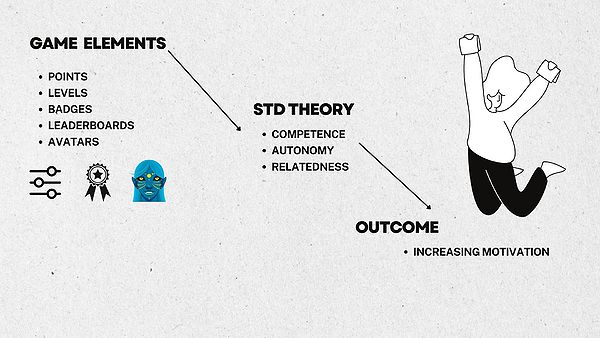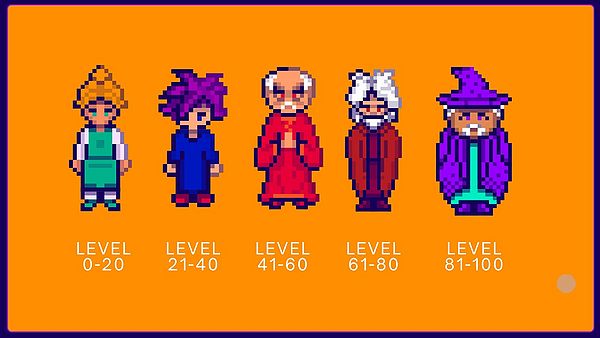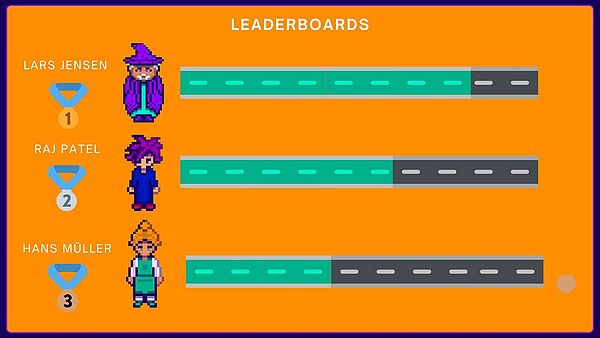Boosting Team Engagement through Gamification: Mitigating the Effects of Social Loafing
Developed by Francesco Magnani- s230227
Contents |
Abstract
Gamification has recently attracted the attention of academics, educators, and practitioners from a number of fields. The idea of "gamification" is not new, it has been a trend in the business and marketing sectors for the past several years. Clarifying the terminology and ideas surrounding “Gamification” is one contribution of this study [1]. Using gamification in a project, program, and portfolio management is becoming increasingly popular as a way to reduce social loafing and improve team performance. This paper provides a theory of work gamification that positions it as a planned improvement to the conventional practice of performance management. Gamification is the process of integrating game principles and components into real-world settings like the workplace and commerce. Workplace gamification does not entail turning work into a game; rather, it involves integrating game elements to motivate and guide desirable employee behavior. For instance, points, levels, badges, leaderboards and avatars are game elements that are frequently linked to gamification. Gamification in this context aims to instil a sense of accountability and competition among team members, hence lowering the tendency for social loafing, in which individuals do not fully contribute to the group effort [2].
The article explains an overview of what Gamification is and how it can be applied in a work context so as to improve performance both by the individual and the collectivity of work groups; It is divided into the following sections:
1. What is Gamification and its purpose.
2. Gamification in Project Management.
3. Principles of Gamification.
4. Applying Gamification Design Elements.
5. Case Study "Trogon".
6. Conclusion.
The paper also gives an annotated bibliography of meaningful readings to aid firms in applying Gamification in projects, programs, and portfolio management.
What is Gamification and its purpose
Over the last 15 years, there has been a significant increase in the usage of digital games in entertainment and they have become such a vital part of our popular culture that it has become an academic topic of study. These themes have sparked research on their effects and relevance in the digital era, as well as the benefits of digital gaming have encouraged its use in endeavours beyond pure enjoyment. Gamification is the technique of incorporating game-like components into non-game activities to boost motivation and engagement, they are made to exploit human psychology in a similar manner to how games do [3]. It can be used at work to increase team performance by making work more engaging and exciting, as well as making tasks more enjoyable, so that team members perform better, feel more motivated and connect one another more effectively; These gamification strategies have recently been used by companies across industries to improve performance and increase employee engagement[4]. It can be utilized specifically in the workplace for instance introducing challenges, awards, and recognition programmes through badges. When people are part of a larger group, they are less inclined to contribute to group activities, and a behaviour known as social loafing occurs. Gamification can decrease societal laziness by motivating people to take responsibility for their labour and compete with one another; Motivation is the internal force that drives people to carry out tasks and achieve their goals [5] [6]. However, there is no universally accepted definition of gamification yet, attempts to define "gamification" are hampered by the term's ambiguous usage, which also highlights its diversity. This blurs the distinction between systems that use it or are fully-fledged games. The varied use of the term "gamification," which resulted in a range of false positives that expressed comparable but different concepts, was a significant issue in locating acceptable sources. Nevertheless, despite the dearth of empirical evidence and best practices for design and implementation, several attempts have been made to capitalize on the purported motivating benefits of gamification approaches. The conceptual immaturity of gamification and this disagreement among researchers present a chance for further investigation of gamification as a topic of study and method of design[2].
Gamification in Project Management
In the field of project management, gamification can be used to increase team members' engagement by making compelling tasks that employees usually do not find interesting. One of the main challenges is staff motivation, so it is imperative to improve motivation. The PMBOK [7] in relation to the domain of team performance states that “Motivating project team members has two aspects: the first is understanding what motivates project team members to perform and the second is working with project team members in such a way that they remain committed to the project and its outcomes “. Gamification stands as a new working method that exploits design elements such as points, levels, badges and dashboards in order to increase the engagement of the project team members and improve the final performance and deliverables. In order to gamify the processes of the project, the design elements have to be aligned with the project methodology and related standards. As analyzed in the PMBOK, motivation can be intrinsic and extrinsic; Intrinsic motivation is defined as doing a task because it is intrinsically satisfying, whereas extrinsic motivation is defined as performing an action because it results in a separable outcome [7]. Self-Determination Theory (STD) has already been successfully applied in the context of games, emphasizing the importance of the environment in fostering motivation [8]; This part of the article investigates from a psychological point of view using STD theory how gamification design elements such as points, levels, badges and leaderboards might improve employee intrinsic motivation.
The Self-Determination theory explains three basic psychological needs:
-Competence: every human being aspires to feel competent when asked to carry out a task that interacts with the surrounding environment, for example, in a work team. Related to the gamification approach the need for competence can be handled by points, levels, leaderboards and badges. Each of these game elements has the function to provide immediate feedback on the employee's actions.
-Autonomy: Psychological freedom is the sensation of making decisions based on one's own principles and interests without being pressured by others. Related to the gamification approach, the need for autonomy might be resolved using avatars, so that the employees are free to customize their own character without having to worry about external judgement.
-Relatedness: It symbolizes the individual's fundamental need for cohesive integration with the social environment. Related to the gamification approach the need for social relatedness can be influenced by a story given by the type of gamification that the project manager wants to create in a project. Creating a story for a project makes it easier for team members to empathize with their avatars in it. This generates a greater sense of belonging to the project among the workers and stimulates them to complete the project tasks with greater motivation, increasing performance and final outputs [9] [10].
Gamification can assist the project manager to:
1. Improve team performance: As seen in PMBOK; The intrinsic motivations may increase the fun and engagement of project tasks, enhancing team members' performance and productivity [7].
2. Encourage teamwork and collaboration: Gamification can stimulate team members to cooperate to fulfil shared objectives, motivating teamwork and collaboration [5].
3. Raise motivation: by offering challenges, recognition and rewards gamification increases motivation and encourages desired behaviours among team members [8].
4. Foster ongoing skill development: It allows team members to develop their knowledge and abilities giving them the opportunity to work with others in a Gamified environment [10].
5. Promote user engagement and adoption: Gamification of business processes may significantly improve user involvement through the implementation of project-gamified tools and systems, making work simpler and more enjoyable. [11].
6. Track and evaluate progress: Gamification gives to project managers insightful real-time data about team performance and progress, improving the decision-making process [3].
Principles of Gamification
Enterprise systems are now essential to how an organization runs. They might not provide the strategic or competitive advantages that firms want if they are not used effectively. As is explained in the article Gamification of Enterprise Systems "Based on a review of the literature on gamification, eight basic principles of Gamification are identified: Challenge (C), Interactivity (I), Goal Orientation (G), Social Connectivity (S), Competition (C), Achievement (A), Reinforcement (R), and Fun Orientation (F). We termed them the CIG-SCARF principles of gamification” [11].
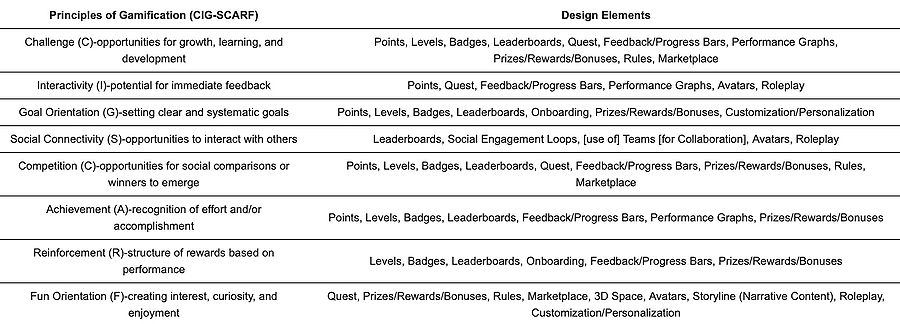
Challenge (C) and Interactivity (I): Collaboration among different functions is essential for the successful implementation of an enterprise system. These principles (C) and (I) can be used to encourage communication and cooperation by posing problems and challenges to cross-functional teams and providing quick feedback; Giving users rapid and accurate feedback (I) is crucial because it encourages user engagement with the system, which is a prerequisite for flow. Competition (C) in a team is essential to encourage learning, however, the system must be balanced in order to have a fair degree of difficulty in the tasks; As a high level of challenge can lead to anxiety or irritation and a low level of challenge can lead to boredom or indifference. problem solving and creativity, enterprise system challenges should be seen as opportunities for users to expand their knowledge and skills, not to discourage them [11].
Goal orientation (G); The process of gamifying work through an orientation to a mission or task has many benefits. These goals in gamified systems guide users on what actions to take and what behaviours are valued. These goals should provide users with new and exciting challenges to undertake. Subgoals may also be included within individual goals, allowing users to achieve minor accomplishments (A) while working towards larger missions. To introduce users to a new gamification system, onboarding missions can be created to encourage them to explore different features of the system. To promote social interactions and a sense of community team-based goals can be implemented, which require multiple users to work together. Another type of goal involves completing specific missions within a given time frame, adding a time-pressure element to the challenge. [5].
Social Connectivity (S) generates shared objectives and a sense of significance, improving intrinsic motivation for system use; This promotes the flow state's three essential components of focused concentration, temporal distortion, and happiness.
Reinforcement (R) is focused on offering performance-based rewards where positive rewards incentivize behaviour repetition. Creating interest, curiosity, and enjoyment in a task or environment is referred to as fun orientation (F) [11].
Applying Gamification Design Elements
The medium used to apply these CIG-SCARF principles are Design elements; the use of game-like elements such as avatars, points, badges and leaderboards can help to provide a more immersive and engaging experience for team members, resulting in increased productivity and better project outcomes, the game design elements sustain the eight gamification principles discussed [11].
This section will delve deeper into the use of these elements in project management and their application in motivating and engaging teams. Consider the following four key design game elements: points, levels, badges, leaderboards. These elements can be used to increase team member engagement and motivation, provide a sense of accomplishment and recognition, and encourage competition and collaboration. Each element will be explained by giving an example of its application in project management practices [5].
Avatars
Avatars are graphical representations of people or groups that can be used to personalize the gamification experience, giving users a sense of identity and ownership. They are used extensively in games and have been proven to improve the overall gaming experience as well as increase player motivation and engagement. In a project, avatars serve the same purpose, they can represent individual teams or team members, providing a visual indicator of progress and achievements. For example, a team's avatar can change as they progress through levels or complete specific tasks or a certain number of badges, providing a clear sense of accomplishment and recognition. Avatars can also encourage competition and team collaboration by representing top-performing teams or individuals with superior or visually impressive avatars. In addition, the possibility of being represented in the company system by an avatar or by a stylized or imaginative image could decrease the possibility of being described by gender, race or similar factors.
Overall, avatars are useful to improve interactivity (I), social connectivity (S) and fun elements (F) among the team's members [5] [11] [10].
Points as feedback and reward
Points are a fundamental component of gamification related to the enterprise system, and they are typically awarded for successfully completing activities in the gamified environment. A points and rewards system is a gamification technique that incentivizes individuals or teams to achieve specific goals such as tasks or milestones (G). Different types of points, such as experience points, redeemable points, or reputation points, can be distinguished, and they serve to numerically represent an employer's progress. One of the most important functions of points is to provide feedback by measuring players' in-game behavior and serving as continuous and immediate feedback and reward. The number of points represents the importance or scope of the tasks, it is critical to carefully design point systems to value user actions. If typical work tasks are difficult to compare, different organizational units may use different point systems. Users can also share points with one another to recognize outstanding achievements, creating an altruistic dynamic. Points provide critical information to both the user and the project managers. The team members receive immediate feedback on their progress, on the other hand, the project manager can track, evaluate, and reward user performance using points [5] [2] [11].
Limitations of the Points System
One limitation of the point system is that it may not be appropriate for all types of tasks or activities. For example, if the goal is to encourage creative thinking, a point system may not be appropriate. In these cases, a more open-ended approach to gamification may be more effective. Another limitation is that Users may be motivated to complete a greater number of tasks in order to earn points under the point system, leading them to prioritize quantity over quality and ignore the impact or quality of their work, which could result in a decrease in overall performance and a lack of creativity and innovation [12].
Badge and Levels
Badges are used in gamification environments as visual representations of achievements that can be earned and collected. Badges serve a variety of functions, including confirming the player's accomplishments (A), symbolizing their merits, and visibly displaying their achievement of levels or goals (G). The levels, which represent intermediate goals, serve as milestones, and badges are awarded to indicate a certain level of achievement. A badge may be awarded based on a specific number of points or on specific activities within the game. Badges perform several functions, including serving as goals when the player is aware of the requirements for winning them and serving as virtual status symbols. Badges, like points, provide feedback by indicating how the players performed. To incentivize the reinforcement (R) in a gamification system, a possible strategy is to enrich the badges with descriptions accompanied by engaging narrative elements that explain how to obtain them. This technique increases the goal orientation (G) and engagement of team members by working on their intrinsic motivations. It has been asserted that badges serve as a guidance mechanic in un project, providing the user with an idea of how to deal with the tasks that are intended to be achieved; Thereby increasing the amount and quality of actions. Another reason for gamification is to capitalize on the persuasive power that emerges when people compare their points and badges with one another, effectively benchmarking themselves. This phenomenon is known as a social comparison (S) [13] [2] [10].
Limitations of Badges
One of the limitations of badges in gamification is their ineffectiveness in complex or open-ended tasks. Because such tasks necessitate greater autonomy and decision-making power, badges may not be an appropriate motivator for users who may require more intrinsic or social forms of motivation to feel engaged. As a result, it may be necessary to supplement the use of badges with other forms of gamification, such as leaderboards in these types of tasks to provide a more nuanced and personalized approach to motivation. Furthermore, badges may be perceived as superficial or arbitrary, resulting in a lack of engagement or even resentment of the gamification program [3] [13].
Leaderboards
Leaderboards are competitive progress indicators that rank players based on their relative success, as measured against a specific success criterion. They aid in determining who excels at a particular activity; Leaderboards are effective motivators when there are only a few points separating players from the next level or position but they can be demotivators when players find themselves at the bottom of the leaderboard. Leaderboard competition can put social pressure on players to increase their level of engagement (C), which can boost participation and learning. These positive effects of competition, however, are more likely if the competitors are performing at the same level. One of the main function of this tool is to rank users based on measurable characteristics such as points or levels, encouraging user competition and fostering engagement (S) [11] [5] [10].
Limitations of Leaderboards
However, when implementing leaderboards, certain factors must be considered. For example, the highest ranks may appear unattainable in rankings with thousands of users, discouraging users from participating. Likewise, new users may find it difficult to catch up with long-time users who have accumulated many points. To avoid such demotivation, the representation of leaderboards can be changed. For example, multiple leaderboards with different time periods or contexts can be used to allow users in the back to compete for the top spots. Furthermore, users can be chosen in a specific context to compare themselves to friends, work colleagues, or departments. In some corporates, a short clip of the leaderboard can also be displayed, showing the user's current position as well as the positions of a few other users directly above and below them. Finally, rankings can be waived in areas where cooperation is desired to avoid negative competition [5] [11] [10].
Case study “Trogon”
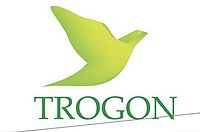
Gamification can be applied to a project management system to increase employee motivation and engagement; An exciting solution has been implemented to Gamify “Trogon” a project management system. The Trogon PMS's gamification layer was contained within a separate module to enable a successful implementation. Trogon PMS's gamified version includes the three primary gamification components: leaderboards, badges and avatars; Moreover, a holistic representation of the company's current projects thanks to an interesting gamification process. First, rankings in the leaderboard promote a culture of competitiveness among individual employees and help the project manager to identify the worker who achieved the highest level of success in completing the project. However, some studies suggest that leaderboards may diminish job performance instead of improving it because they make employee performance public and visible to everyone in the workplace. To solve this problem, rankings merely display differences between players rather than actual numbers. While the points and levels accumulated by employees can only be displayed privately, so as not to demoralize those who are not as effective.[14].
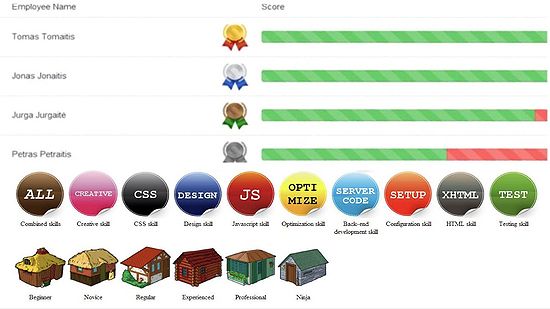
Badges in this implementation are identified as merit awards to the worker and are obtained through the achievement of a certain set of skills obtained by the worker based on tot tasks completed as observed in Figure 6. These public awards make the work environment much more stimulating as the worker's prestige and flexibility are derived in part from them. In this case study; Each team member is identified within the project with a house-shaped avatar that changes structure and colour based on each member's level. Avatars serve as a graphical representation of team members' successes and make team members feel more united and motivated. This humorous approach to project management not only makes the process more engaging and enjoyable for team members but also promotes a sense of friendly competition and teamwork, which leads to improved performance and results. In general, we can say that the gamification of points, levels, leaderboards and avatars facilitates the monitoring and improvement of KPIs.
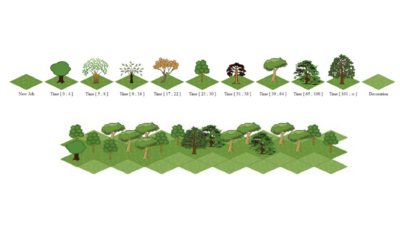
The forest in Figure 7 presents a more intuitive and visually appealing way to track project progress, with unoccupied plots representing incomplete tasks and trees symbolizing completed tasks. This visual representation can be engaging and easier to understand for both project managers and team members, allowing them to quickly assess the complexity and timing of activities and compare the performance of different team members. This visualization is not intended to be a replacement for the Gantt chart, which employs a linear representation of activities and deadlines. Instead, it seeks to provide an alternate tool that is easier to use and more dynamic for individuals who are unfamiliar with the Gantt chart. Alternatively, it provides the project manager with a more effective perspective of the project in order to accelerate decision-making on resource allocation and management. [14].
Conclusion
Taking everything into account, in today's fast-paced work environment, gamification has become a powerful tool to enhance team members' performance and engagement. By incorporating game design elements, organizations can inspire and guide their staff toward achieving goals; Improving team engagement and reducing social loafing among team members. Nevertheless, gamification is not a cure-all for business problems and contextual factors such as the target audience, design elements, and workplace culture can affect its efficacy. Additionally, like any game, gamification can lose its effectiveness over time. Hence, project managers must consistently innovate by introducing new rewards, challenges and tasks to maintain user engagement and a competitive team. While gamification can transform the way we work, it requires careful consideration and ongoing modifications to be effective. Ultimately, it is up to companies and their managers to intelligently find innovative solutions to utilize gamification in order to improve employee performance, engagement, and productivity.
Annotated Bibliography
Ryan, R. M., & Deci, E. L. (2017). Self-determination theory: Basic psychological needs in motivation, development, and wellness. The Guilford Press.
This book is a comprehensive volume that explores the theory of self-determination and its relevance to human motivation, development, and well-being; I invite the reader to carry out an additional reading to better understand how this theory can be applied to gamification to work on the intrinsic motivations of employees.
Project Management: A guide to the Project Management Body of Knowledge (PMBOK guide), 7th Edition
PMBOK is a comprehensive guide to project management principles, best practices, and techniques. Project managers who are involved in managing projects must have a reference to the PMBOK; It is crucial to adapt gamification in accordance with the best practices outlined in the PMBOK guide in order to implement it in a project successfully.
- ↑ C. M. Teresa, G. B. Northcraft and J. Whicker, "A theory of work gamification: Something old, something new, something borrowed, something cool?," Human Resource Management Review, vol. 27, no. 2, pp. 353-365, 2017.
- ↑ 2.0 2.1 2.2 2.3 D. I. Fels and K. Seaborn, "Gamification in theory and action: A survey," International Journal of Human-Computer Studies, vol. 74, pp. 14-31, 2015.
- ↑ 3.0 3.1 3.2 S. Deterding, D. Dixon, Nacke and L. Nacke, "From game design elements to gamefulness: defining "gamification"," in International Academic MindTrek, 2011.
- ↑ D. Dicheva and C. Dichev, "Gamifying education: what is known, what is believed and what remains uncertain: a critical review," international Journal of Educational Technology in Higher Education, vol. 14, 2017.
- ↑ 5.0 5.1 5.2 5.3 5.4 5.5 5.6 5.7 K. Augustin, S. Thiebes, S. Lins and R. Linden , "Are We Playing Yet? A Review of Gamified Enterprise Systems" in Pacific Asia Conference on Information Systems, 2016.
- ↑ S. J. Karau and W. Kipling D., "Social Loafing: A Meta-Analytic Review and Theoretical Integration," Journal of Personality and Social Psychology, vol. 65, p. 681–706, 1993.
- ↑ 7.0 7.1 7.2 "A Guide to the Project Management Body of Knowledge (PMBOK Guide) -- Seventh Edition and The Standard for Project Management": Seventh edition. | Newtown Square, Pennsylvania: Project Management Institute, Inc,2021.
- ↑ 8.0 8.1 ADELE H. T. KAM*, IRFAN N. UMAR "FOSTERING AUTHENTIC LEARNING MOTIVATIONS THROUGH GAMIFICATION: A SELF- DETERMINATION THEORY (SDT) APPROACH", Journal of Engineering Science and Technology, November (2018).
- ↑ Ryan, R. M., & Deci, E. L. (2017). Self-determination theory: Basic psychological needs in motivation, development, and wellness. The Guilford Press.
- ↑ 10.0 10.1 10.2 10.3 10.4 10.5 M. Sailer, . J. U. Hense, M. Sarah Katharina and H. Mandl, "How gamification motivates: An experimental study of the effects of specific game design elements on psychological need satisfaction," Computers in Human Behavior, vol. 69, pp. 371-380, 2017.
- ↑ 11.0 11.1 11.2 11.3 11.4 11.5 11.6 11.7 11.8 11.9 F. Fui-Hoon Nah, ,. B. Eschenbrenne, C. C. Claybaugh and P. B. Koob, "Gamification of Enterprise Systems," Systems, vol. 7, no. 1, 2019.
- ↑ J. Hamari, J. Koivisto and H. Sarsa, "Does Gamification Work? — A Literature Review of Empirical Studies on Gamification," in the 47th Hawaii International Conference on System Sciences, Hawaii, USA, 2014.
- ↑ 13.0 13.1 J. Hamari, "Do badges increase user activity? A field experiment on the effects of gamification," Computers in Human Behavior, vol. 71, pp. 469-478, 2917.
- ↑ 14.0 14.1 14.2 14.3 14.4 Darius Ašeriškis, Robertas Damaševičius, "Gamification of a Project Management System"The Seventh International Conference on Advances in Computer-Human Interactions,2014.
